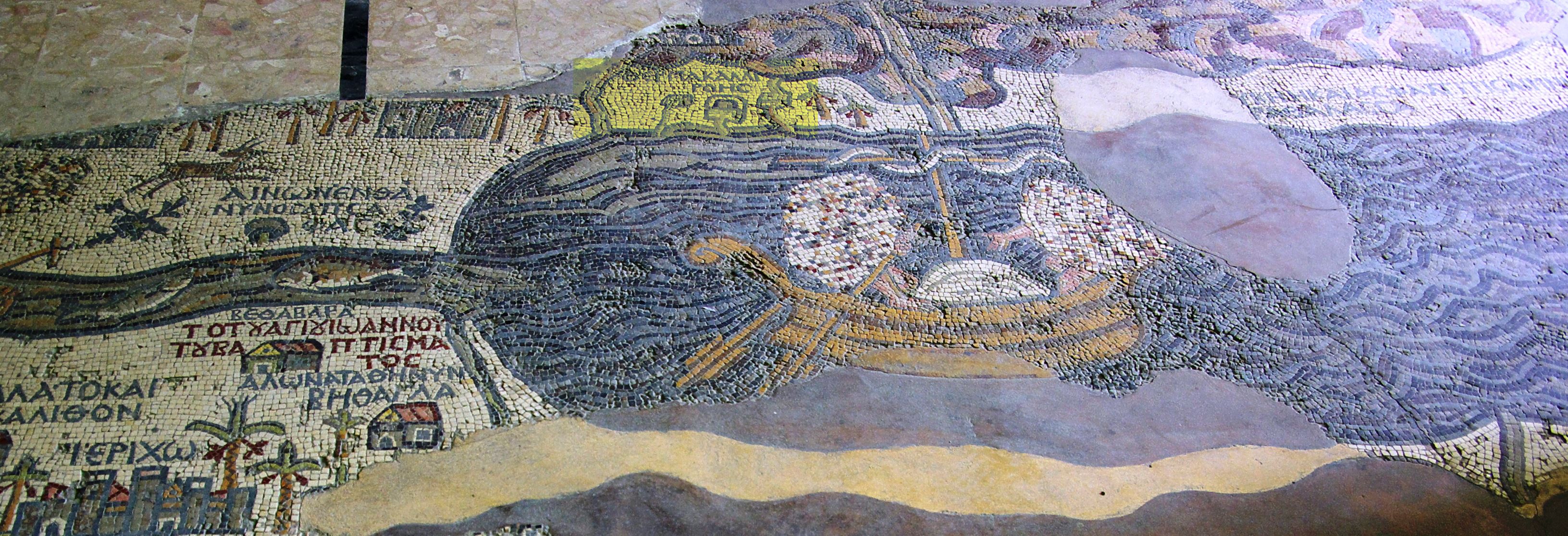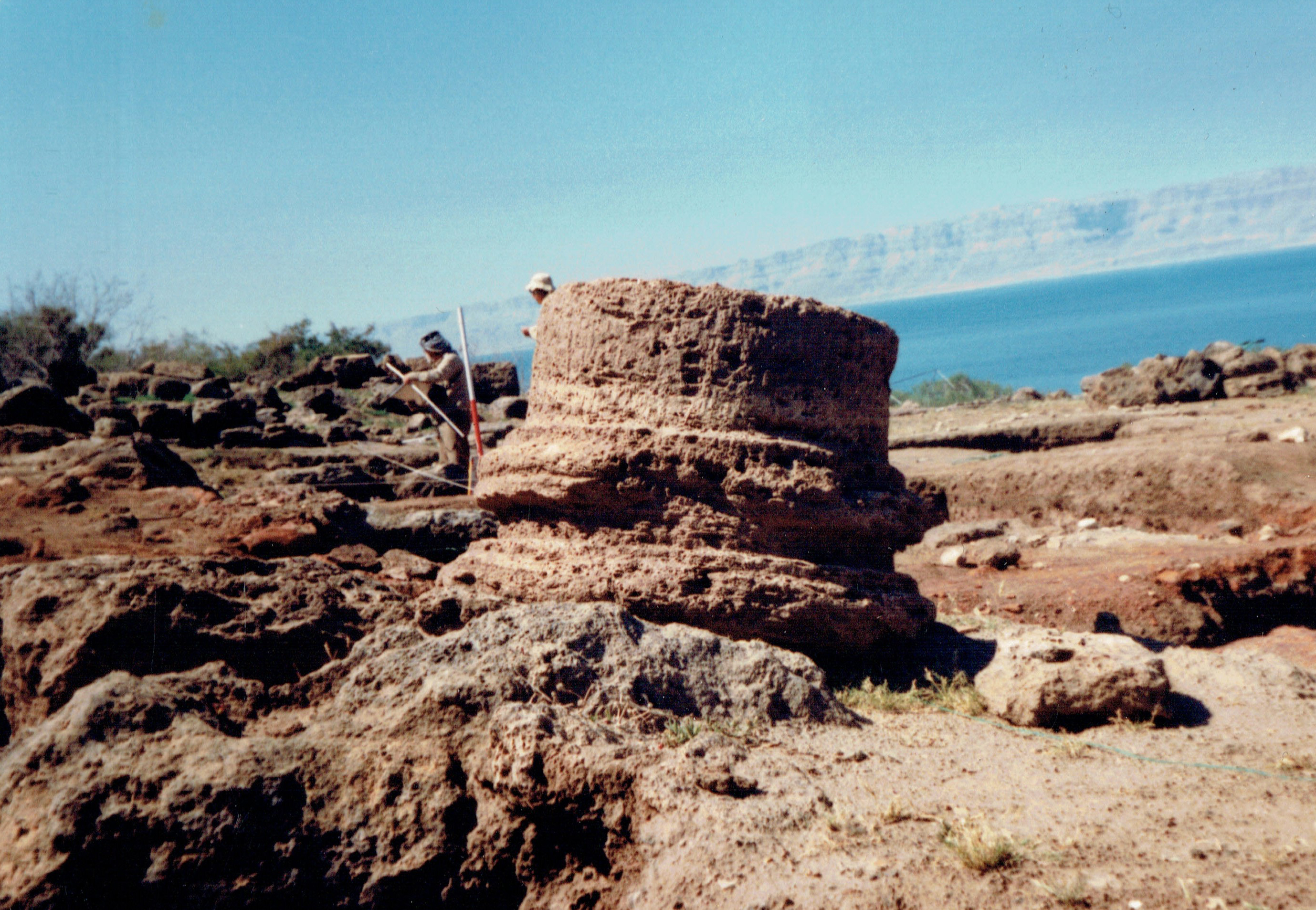Callirrhoe (Jordan) on:
[Wikipedia]
[Google]
[Amazon]
Callirrhoe or Callirrhoë ( ar, عين الزارة, ''' Ein ez-Zara''; grc-gre, Θερμὰ Καλλιρόης, ''Thermà Kallirhoēs'') is an
 Callirrhoe is represented on Madaba Map. On the mosaic three
Callirrhoe is represented on Madaba Map. On the mosaic three 
Photos of Ayn ez Zara
at the
archaeological site
An archaeological site is a place (or group of physical sites) in which evidence of past activity is preserved (either prehistoric or historic or contemporary), and which has been, or may be, investigated using the discipline of archaeology an ...
in Jordan
Jordan ( ar, الأردن; tr. ' ), officially the Hashemite Kingdom of Jordan,; tr. ' is a country in Western Asia. It is situated at the crossroads of Asia, Africa, and Europe, within the Levant region, on the East Bank of the Jordan Ri ...
in which remains of a nymphaeum
A ''nymphaeum'' or ''nymphaion'' ( grc, νυμφαῖον), in ancient Greece and Rome, was a monument
A monument is a type of structure that was explicitly created to commemorate a person or event, or which has become relevant to a so ...
can be traced, though it is considered difficult to be interpreted. Callirrhoe is known in ancient literature for its thermal springs, because it was visited by King Herod according to Josephus
Flavius Josephus (; grc-gre, Ἰώσηπος, ; 37 – 100) was a first-century Romano-Jewish historian and military leader, best known for '' The Jewish War'', who was born in Jerusalem—then part of Roman Judea—to a father of priestly d ...
shortly before his death, as a final attempt to be cured or relief his pains. It remains unknown if the ''greatest builder in Jewish history'' is related to any of the observable remains in the area. Callirrhoe is referred by Pliny the Elder
Gaius Plinius Secundus (AD 23/2479), called Pliny the Elder (), was a Roman author, naturalist and natural philosopher, and naval and army commander of the early Roman Empire, and a friend of the emperor Vespasian. He wrote the encyclopedic ...
(''Natural History'', 70-72), Ptolemaeus (''Geography'' 15,6) and Solinus Solinus may refer to:
* Gaius Julius Solinus, a 3rd century Latin author
* Solinus (horse), a British racehorse (1975–1979)
* Solinus, Duke of Ephesus, a character in William Shakespeare's play ''The Comedy of Errors''
See also
* Salinas (disam ...
(''De mirabilibus mundi'' 35,4) as well as in a Midrash
''Midrash'' (;"midrash"
''Random House Webster's Unabridged Dictionary''. he, מִדְרָשׁ; ...
.
''Random House Webster's Unabridged Dictionary''. he, מִדְרָשׁ; ...
Names
TheGreek
Greek may refer to:
Greece
Anything of, from, or related to Greece, a country in Southern Europe:
*Greeks, an ethnic group.
*Greek language, a branch of the Indo-European language family.
**Proto-Greek language, the assumed last common ancestor ...
name ''Kallirhoē'' means "beautiful brook" or "spring". The Arabic
Arabic (, ' ; , ' or ) is a Semitic language spoken primarily across the Arab world.Semitic languages: an international handbook / edited by Stefan Weninger; in collaboration with Geoffrey Khan, Michael P. Streck, Janet C. E.Watson; Walte ...
name ''Ayn az-Zara'' is sometimes derived from the root ''zar'a'' ("to sow"), in view of the agricultural function of the oasis. More probable is its derivation from an unattested original form ''al-Ayn az-Zahra'' ("the shining spring"), acting as a direct calque
In linguistics, a calque () or loan translation is a word or phrase borrowed from another language by literal word-for-word or root-for-root translation. When used as a verb, "to calque" means to borrow a word or phrase from another language ...
of the Greek.
Madaba Map
 Callirrhoe is represented on Madaba Map. On the mosaic three
Callirrhoe is represented on Madaba Map. On the mosaic three construction
Construction is a general term meaning the art and science to form objects, systems, or organizations,"Construction" def. 1.a. 1.b. and 1.c. ''Oxford English Dictionary'' Second Edition on CD-ROM (v. 4.0) Oxford University Press 2009 and ...
s can be observed, a spring house, a nymphaeum, and a house. Springs' waters are gathered in basins, and two little palm trees are discerned representing the oasis
In ecology, an oasis (; ) is a fertile area of a desert or semi-desert environmentDead Sea
The Dead Sea ( he, יַם הַמֶּלַח, ''Yam hamMelaḥ''; ar, اَلْبَحْرُ الْمَيْتُ, ''Āl-Baḥrū l-Maytū''), also known by other names, is a salt lake bordered by Jordan to the east and Israel and the West Bank ...
south of Wadi Zerka Ma'in in Jordan
Jordan ( ar, الأردن; tr. ' ), officially the Hashemite Kingdom of Jordan,; tr. ' is a country in Western Asia. It is situated at the crossroads of Asia, Africa, and Europe, within the Levant region, on the East Bank of the Jordan Ri ...
. It was founded circa 1st century BCE and excavations
In archaeology, excavation is the exposure, processing and recording of archaeological remains. An excavation site or "dig" is the area being studied. These locations range from one to several areas at a time during a project and can be condu ...
between 1985 and 1989 were directed by August Strobel on behalf of the German Evangelical Institute for the Ancient Holy Land.
A villa
A villa is a type of house that was originally an ancient Roman upper class country house. Since its origins in the Roman villa, the idea and function of a villa have evolved considerably. After the fall of the Roman Republic, villas became s ...
of the 1st century CE, uncovered in recent excavations, is considered to be inspired by the designs used by Herod for his palaces. Callirrhoe functioned as harbor site for the mountain fortress of Machaerus. An ancient road of 8 km length connects the two sites.

References
External links
*{{cite web, url=http://www.christusrex.org/www1/ofm/mad/, title=Madaba Mosaic Map, accessdate=2 April 2016, archive-url=https://web.archive.org/web/20160414203937/http://www.christusrex.org/www1/ofm/mad/, archive-date=14 April 2016, url-status=deadPhotos of Ayn ez Zara
at the
American Center of Research
The American Center of Research (ACOR) is a private, not-for-profit scholarly and educational organization. Based in Alexandria, Virginia, with a facility in Amman, Jordan, ACOR promotes knowledge of Jordan and the interconnected region, past and ...
Archaeological sites in Jordan
Hot springs